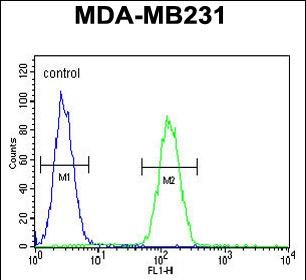STX7 Antibody (N-term)
Affinity Purified Rabbit Polyclonal Antibody (Pab)
- SPECIFICATION
- CITATIONS
- PROTOCOLS
- BACKGROUND

Application
| FC, IHC-P, WB, E |
|---|---|
| Primary Accession | O15400 |
| Other Accession | O70257, O70439, Q3ZBT5, NP_003560.2 |
| Reactivity | Human |
| Predicted | Bovine, Mouse, Rat |
| Host | Rabbit |
| Clonality | Polyclonal |
| Isotype | Rabbit IgG |
| Calculated MW | 29816 Da |
| Antigen Region | 47-73 aa |
| Gene ID | 8417 |
|---|---|
| Other Names | Syntaxin-7, STX7 |
| Target/Specificity | This STX7 antibody is generated from rabbits immunized with a KLH conjugated synthetic peptide between 47-73 amino acids from the N-terminal region of human STX7. |
| Dilution | FC~~1:10~50 IHC-P~~1:50~100 WB~~1:1000 E~~Use at an assay dependent concentration. |
| Format | Purified polyclonal antibody supplied in PBS with 0.09% (W/V) sodium azide. This antibody is purified through a protein A column, followed by peptide affinity purification. |
| Storage | Maintain refrigerated at 2-8°C for up to 2 weeks. For long term storage store at -20°C in small aliquots to prevent freeze-thaw cycles. |
| Precautions | STX7 Antibody (N-term) is for research use only and not for use in diagnostic or therapeutic procedures. |
| Name | STX7 |
|---|---|
| Function | May be involved in protein trafficking from the plasma membrane to the early endosome (EE) as well as in homotypic fusion of endocytic organelles. Mediates the endocytic trafficking from early endosomes to late endosomes and lysosomes. |
| Cellular Location | Early endosome membrane; Single- pass type IV membrane protein |
| Tissue Location | Highest expression is found in placenta followed by heart, skeletal muscle, kidney and brain. Low expression is found in pancreas, lung and liver |

Thousands of laboratories across the world have published research that depended on the performance of antibodies from Abcepta to advance their research. Check out links to articles that cite our products in major peer-reviewed journals, organized by research category.
info@abcepta.com, and receive a free "I Love Antibodies" mug.
Provided below are standard protocols that you may find useful for product applications.
Background
Syntaxin 7 is involved in the ordered fusion of endosomes and lysosomes with the phagosome, where phagocytic cells kill and degrade internalized foreign particles. Syntaxin 7 is found in late endosomes and lysosomes; whereas Syntaxin 12 is localized to the recycling endosome compartment, both are recruited to the phagosome. However, STX12 is acquired earlier before rapidly recycling off the phagosome, whereas STX7 is recruited later and continues to accumulate throughout the phagosome maturation process.
References
Prekeris, R., et al. Mol. Biol. Cell 10(11):3891-3908(1999)
Steegmaier, M., et al. J. Biol. Chem. 273(51):34171-34179(1998)
Wong, S.H., et al. J. Biol. Chem. 273(1):375-380(1998)
Wang, H., et al. Gene 199 (1-2), 39-48 (1997)
If you have used an Abcepta product and would like to share how it has performed, please click on the "Submit Review" button and provide the requested information. Our staff will examine and post your review and contact you if needed.
If you have any additional inquiries please email technical services at tech@abcepta.com.













 Foundational characteristics of cancer include proliferation, angiogenesis, migration, evasion of apoptosis, and cellular immortality. Find key markers for these cellular processes and antibodies to detect them.
Foundational characteristics of cancer include proliferation, angiogenesis, migration, evasion of apoptosis, and cellular immortality. Find key markers for these cellular processes and antibodies to detect them. The SUMOplot™ Analysis Program predicts and scores sumoylation sites in your protein. SUMOylation is a post-translational modification involved in various cellular processes, such as nuclear-cytosolic transport, transcriptional regulation, apoptosis, protein stability, response to stress, and progression through the cell cycle.
The SUMOplot™ Analysis Program predicts and scores sumoylation sites in your protein. SUMOylation is a post-translational modification involved in various cellular processes, such as nuclear-cytosolic transport, transcriptional regulation, apoptosis, protein stability, response to stress, and progression through the cell cycle. The Autophagy Receptor Motif Plotter predicts and scores autophagy receptor binding sites in your protein. Identifying proteins connected to this pathway is critical to understanding the role of autophagy in physiological as well as pathological processes such as development, differentiation, neurodegenerative diseases, stress, infection, and cancer.
The Autophagy Receptor Motif Plotter predicts and scores autophagy receptor binding sites in your protein. Identifying proteins connected to this pathway is critical to understanding the role of autophagy in physiological as well as pathological processes such as development, differentiation, neurodegenerative diseases, stress, infection, and cancer.




